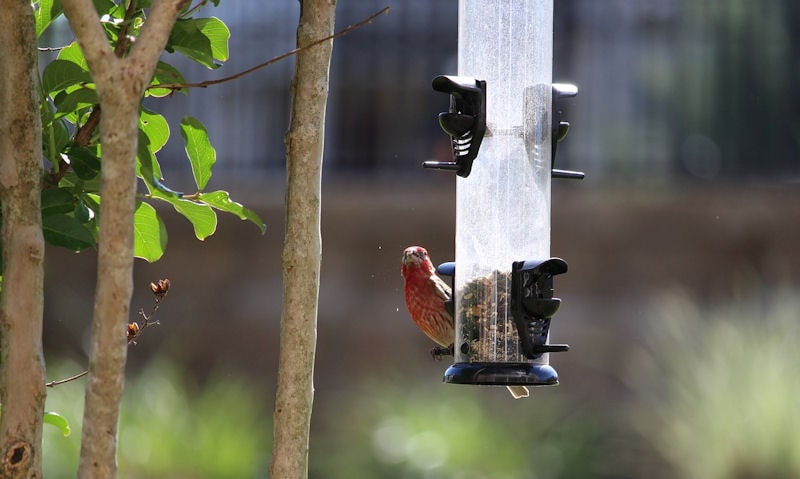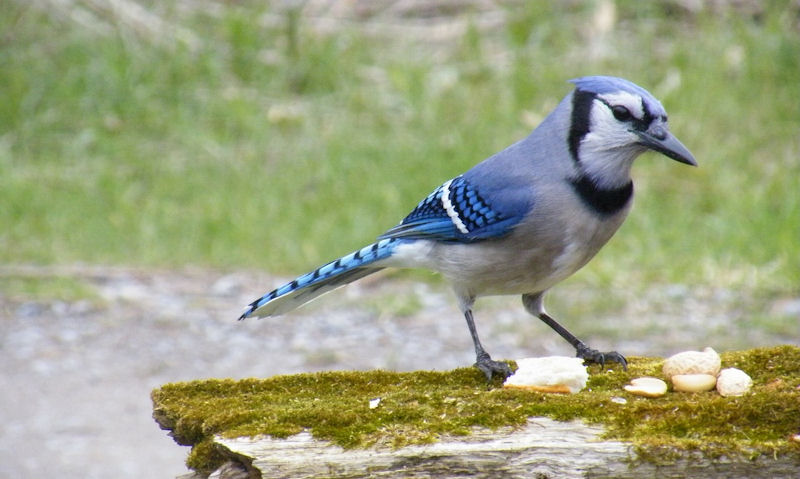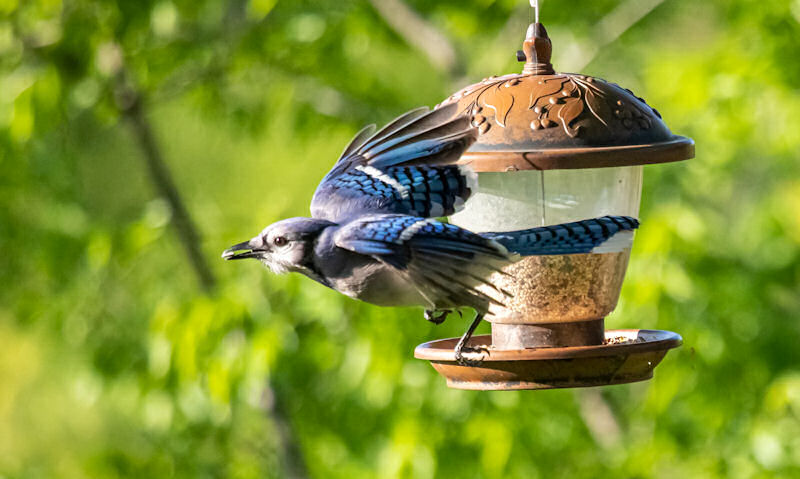How to keep Blue Jays out of feeders
What is essentially one of the most reliable backyard birds, and therefore a common bird feeder bird, will need an effective way to keep them out of all types of bird feeders.
How to keep Blue Jays out of feeders relies on a small, compact feeder which provides little way for this large bird to perch. Same feeders can be hung beneath a closed baffle above, with squirrel proof bird feeder cages an option. In the end, feeding Blue Jays in an open dish could distract them off your feeders.
How you will manage to keep Blue Jays off any type of bird feeder will indeed take a lot of time and effort, but in the end it may come down to feeding them.
What could be the only solution is to actually feed Blue Jays their favorite peanuts or sunflower seeds in a stabilized open dish or bird feeder tray, which you will permit access to Blue Jays who are intent on scaring off friendly songbirds on bird feeders.
Blue Jays are found in most of our gardens of course and therefore have been a reliable bird feeder bird over decades.
If its a small compact feeder or a wide open dish, you can guarantee Blue Jays will find it, and will eventually succeed in reaching the bird food.
How we can keep Blue Jays away from bird feeders is to apply some techniques we use to deter pigeons, and squirrels especially.
Squirrel baffle hung above hanging feeders is a sure fire way of limiting a Blue Jays access, as their wide wingspan risks hitting the baffle they are attempting to land under to perch on the feeder.
Better yet, to utilize squirrel proof bird feeders - with a cage surround - the bird feeders, and therefore bird feeder food, will remain out of reach at the center.
Admittedly, songbirds could refuse to enter a confined cage as it can feel unsafe to them, whereas Blue Jays can on occasions still pass in between the wire cage gaps.
Supply feed in tricky feeders

It won't be easy to keep Blue Jays out of bird feeders because this is one of the most common backyard birds in the United States; together with a common bird feeder bird who are frequently found on bird feeders.
Bird feeders could be open to larger birds like Blue Jays while they will also be found on more difficult to access bird feeders.
And this is why it will be difficult for you to deter Blue Jays on bird feeders, because they have adapted to all kinds of common feeders, that are hung up or mounted.
Let's not forget Blue Jays favorite bird food is also readily available including seeds with sunflower seeds - plus in or out of shell peanuts - so why wouldn't they try.
With determined Blue Jays to contend with then, you'll have to pack away accessible bird feeders to replace them with hard to access feeders.
Not impossible I might add, but a more confined bird feeder can make it hard for Blue Jays - including Steller's Jay - to perch against a hanging feeder due to their wide girth.
How to feed small birds only which should mostly exclude Blue Jays would now rely on a long, clear tube feeder, mostly reserved for a mix of seeds.
Its a tried and tested technique that can certainly allow you to feed small songbirds while deterring pigeons accessing the same feeding area. Blue Jays though aren't as clumsy like pigeons or doves, thus some adjustments on your part could be required over the long run.
Close the gap under dome
It was only a matter of time before I recommended some kind of squirrel baffle to deter large birds, and believe me when I tell you a baffle can be quite effective to keep large birds off bird feeders of any kind.
What you will do is utilize the hanging style squirrel baffle that are strung above feeders.
Oppose to squirrel baffles that are mounted to a bird feeder pole in which this technique doesn't apply to, as birds can simply perch above pole mounted baffles.
With the squirrel baffle hung above any active bird feeder, it can make it difficult for a wide wingspan Blue Jay to perch beneath the baffle.
Unfortunately as I've mentioned Blue Jays will be quite determined to land on a feeder where bird food is up for grabs; thus they will continue to attempt to land under a hanging baffle until they succeed, and often they do.
What you can do now then is to be sure the bird feeder hung below the baffle, is raised up and under the baffle as far as it will go.
Baffle surrounding a feeder hung high beneath it can make it even more difficult for Blue Jays to perch under such a tight squeeze.
Squirrel proof feeder varieties
Now this may not apply to your current crop of bird feeders, as an additional feeder or two may be needed in an attempt to keep Blue Jays out of them.
Blue Jays can certainly land on bird feeders - even the enclosed, compact kind - but once their there, we need to at least keep the bird feeder food out of reach.
With that in mind you'll need to pack away any open dishes or trays as we can't defend against this kind. Instead its time to rely on squirrel proof bird feeders which must be mounted with a squirrel proof cage only.
If we can squirrel proof hanging bird feeders with a squirrel proof cage like this then we can certainly provide too close together bars, which will hopefully make it impossible for Blue Jays to pass through.
In theory small common songbirds like Finches, Sparrows or Warblers will fit between the wire bars, whereas much larger Blue Jays will be kept on the outside.
Bird feeders are mounted to the middle of squirrel proof bird feeder cage, thus the feeder can be used as normal, only small birds must pass in between gaps in the metal wire cage.
Never use squirrel proof bird feeders that utilizes weight to cut of squirrels, as the weight tension setting won't drop low enough to activate the function to cut off Blue Jay access.
Cover open type suet bird feeders
While I've mostly applied my suggestions on how to keep Blue Jays away from bird feeders of the seed or mesh peanut feeder kind, I haven't given much thought to suet feeders that do remain exposed to Blue Jays.
First thing to do to prevent access to a suet fat ball or suet cake feeder by Jays, is to at least hang the suet feeder all by itself on a long length of steel wire.
Wire so Blue Jays can't cling to it, whereas this will make it difficult for large birds like Jays to land, who do have difficulty on spinning or swinging bird feeders.
Suet feeders that hold suet cakes in particular do have a knack of drastically swinging.
How to squirrel proof a suet feeder will rely on the suet or fat ball feeder hung below a hanging style baffle. Whereas this same baffle will now make it near impossible for a Jay to scoop beneath it in an effort to perch on a small, moving suet feeder.
Never mount or tie a suet feeder to a tree or pole as it will be perfectly stabilized for Blue Jays to land on top to feed; they can also perch on an adjacent object to reach over to the suet to feed on what is essentially an easy meal.
Other types of a suet bird feeders that will keep Blue Jays off is an upside down suet feeder, intended for Chickadees or Woodpeckers.
What else can be effective to keep Blue Jays off suet feeders, like how it can keep even Blackbirds off suet feeders - is to seal off the top section of suet feeders as it will be made impossible for Blue Jays to perch on such a small area lower down on the cage.
Feed Blue Jays to satisfy them

Truth of the matter is Blue Jays will be attracted to your backyard naturally, due to a wide supply of insects on the lawn or vegetation serving up seeds or fruits.
Certainly I don't expect you to completely landscape over your greenery to keep keep a nuisance at the time Blue Jay off your bird feeders.
Though I do have the ideal solution for you which does involve actually feeding Blue Jays rather than allowing them go hungry.
The idea of this method to deter Blue Jays from feeders is to keep them happy by feeding them their favorites, away from your main bird feeder setup.
Now I will admit to feed Blue Jays in one area of the yard while attracting small songbirds to another, has no guarantee.
With that in mind there's certainly no harm in providing an open bird feeder dish for Blue Jays, even if it means smaller songbirds are found to use it at the same time.
How to attract Blue Jays to this particular bird feeder simply relies on a visible to all birds feeder. then Blue Jays will naturally come to it if its always made accessible to them.
Blue Jays will be determined to feed on bird feeders which they will manage to access given some time.
To feed Blue Jays - just as you would feed squirrels to keep them off feeders - will re-focus their attention off your original bird feeder collection that is seeing less use due to nuisance Blue Jays acting aggressive to songbirds and others.
Conclusion
Blue Jays are fairly large compared to the small songbirds the many types of bird feeders are intended for.
With that you could provide only tricky bird feeders that will allow small birds to perch, while kicking off Blue Jays simply because they're too big to perch.
This mostly applies to seed feeders with no seed catcher tray or additional ways to perch, thus its a technique that must be made available on confined bird feeders only in an effort to deter Blue Jays.
With these bird feeders used additional options you could try to keep Blue Jays out of bird feeders could include hanging bird feeders beneath a hanging style squirrel baffle.
It will provide less area for large birds to utilize their wingspan which can make it hard for them to get underneath the baffle.
Better still do raise any bird feeder hung below a squirrel baffle as far up as it will go, as this closed gap would make it even harder for Blue Jays to freely perch underneath.
Squirrel proof bird feeders are another option as the metal cage surround with any type of bird feeder mounted to the center - will allow small songbirds to pass between the gaps - while keeping Blue Jays on the outside.
Suet bird feeders in particular can be hard to defend against large birds, but to follow the rule of hanging a suet cake or fat ball feeder under a baffle, will be a good start.
Blue Jays are a common backyard bird and a reliable bird feeder bird with that, which means little can be done to stop them all together.
Despite that, you could think about feeding Blue Jays on an open tray filled with peanuts in or out of their shell - and a mix of seeds - which could distract this unwanted bird even if the feeder tray must be hung among bird feeders you intend to keep them away from.


